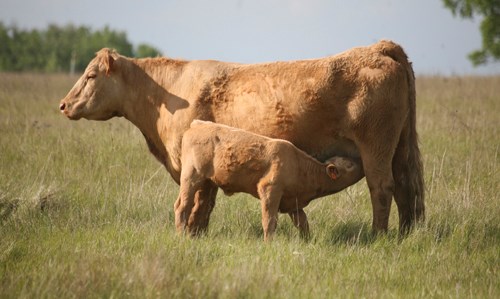When agriculture first boomed in Saskatchewan, the mixed farm was the most popular type of farm. A mixed farm means that the farmers grow crops and raise livestock. In the early 1900s most farms grew a small number of crops, mostly wheat, barley, and oats. They also had small numbers of livestock,a few pigs, some beef cattle, milking cows, and chickens. These animals were mostly for the farmers family's own use.
In the 1936, the number of farms in Saskatchewan reached a historic high. There were 142,000 farms and the province wide farm population was over 500,000 people. The farm population has steadily gone down in numbers since then. In 2006 there were only 44,329 occupied farms.
Of the many farms still remaining, only a select few are dairy related, with a much larger quantity of beef cattle farms.
Approximately 27% of all farms in Saskatchewan are beef cattle operations. Saskatchewan has 33% of the entire Canadian beef herd. Saskatchewan is the second largest beef producing province in Canada, after Alberta.
The number of Saskatchewan dairy farms has rapidly declined recently however, the amount and value of the products have increased over time. In 2003, the average herd size was 85 cows per farm and today the average is 148 cows. The output of each cow has increased to almost three times as much as it was a half-century before. This was caused by new and better housing, feeding practices, and many other modern decisions.
Producers in Saskatchewan now sell over 210 million litres of milk a year, valued at 130 million dollars! The dairy industry adds a lot of value to the Saskatchewan economy.
According to the Canadian government, 182 dairy farms can be found in Saskatchewan, containing 29,000 cows and 15,000 heifers. Canada is home to 2,965 dairy farms.
About 81% of Canadian dairy farms are located in Ontario and Quebec, 13% in the Western provinces and 6% in the Atlantic Provinces. The Canadian dairy cattle population totals 1.4 million and the typical farm has 72 cows.
There are 455 milk processing plants, 274 of which are federally-inspected and contribute to more than 22,650 jobs across Canada.
Although the grain industry and red meat industry are Canada's number one ranked in the Canadian agricultural sector, the dairy industry is a closer third. In 2010, dairy production in Canada generated total net farm receipts of $5.5 billion and sales of $13.7 billion, representing 15% of the Canadian food and beverage sector.
The fluid milk market (table milk and fresh cream) represents 39% of milk production or 29.5 million hectolitres, while the market for manufactured dairy products such as butter, cheese, yogurt and ice cream accounts for 61% of production or 47 million hectolitres of milk.
Out of the 667 distinct varieties of Canadian cheese: 477 varieties are produced in Quebec (71%) 125 varieties are produced in Ontario (19%) 65 varieties are produced in other Canadian provinces (10%).
Strict quality standards applied throughout Canada's production and processing chain contribute to the excellent reputation of Canadian dairy products.
According to Dairy Farmers of Canada, "CFIA is responsible for setting standards for dairy products, for inspecting plants under federal jurisdiction, and for regulating packaging and labelling. CFIA also enforces veterinary health programs and ensures the safety of dairy products.
Thanks to the strict standards in place, several serious cattle diseases have been eradicated from Canadian dairy herds. CFIA ensures the maintenance of national eradication programs and also ensures the mandatory control and monitoring in accordance with international agreements, particularly OIE agreements, protecting Canadian livestock from serious diseases that could restrict trade or pose a risk to human health."
The governments, along with industry professionals, have made the development of a full traceability system a top priority in Canada.
"Canadian traceability systems are based on three basic elements: animal identification, animal movement and premises identification." Explained the Cattle Identification Agency, at last months Ag Ex in Redvers. "The National Livestock Identification for Dairy (NLID) system means all newborn animals, male and female are tagged using the same system."
The Canadian dairy industry is also working on crucial ways to reduce green house gases, and is beginning to put their plans in place.



